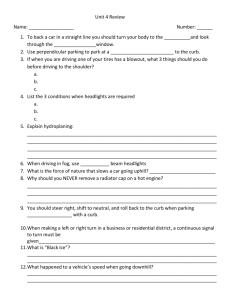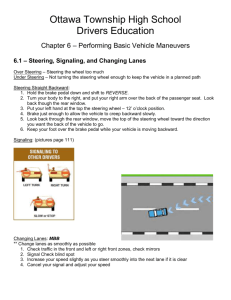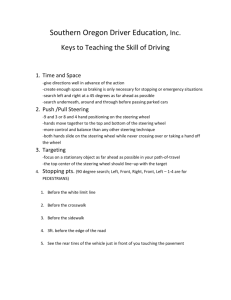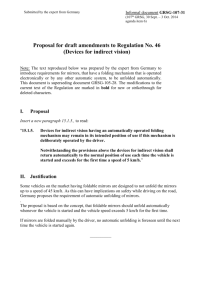Almost all DMV Inspectors will require you to back
advertisement
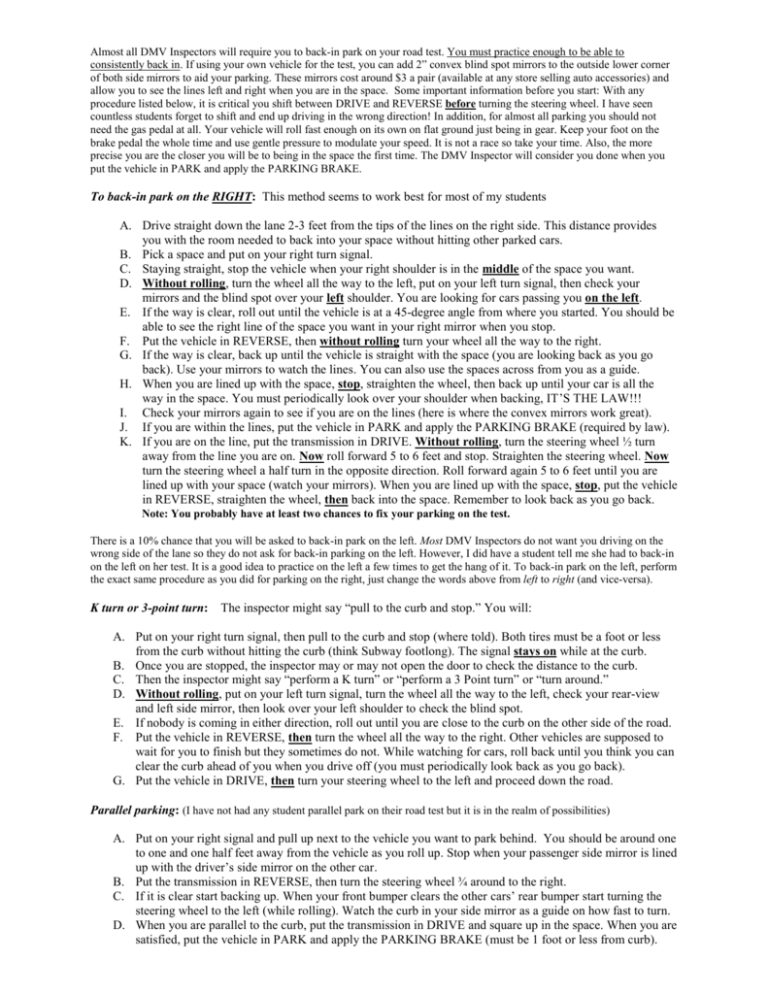
Almost all DMV Inspectors will require you to back-in park on your road test. You must practice enough to be able to consistently back in. If using your own vehicle for the test, you can add 2” convex blind spot mirrors to the outside lower corner of both side mirrors to aid your parking. These mirrors cost around $3 a pair (available at any store selling auto accessories) and allow you to see the lines left and right when you are in the space. Some important information before you start: With any procedure listed below, it is critical you shift between DRIVE and REVERSE before turning the steering wheel. I have seen countless students forget to shift and end up driving in the wrong direction! In addition, for almost all parking you should not need the gas pedal at all. Your vehicle will roll fast enough on its own on flat ground just being in gear. Keep your foot on the brake pedal the whole time and use gentle pressure to modulate your speed. It is not a race so take your time. Also, the more precise you are the closer you will be to being in the space the first time. The DMV Inspector will consider you done when you put the vehicle in PARK and apply the PARKING BRAKE. To back-in park on the RIGHT: This method seems to work best for most of my students A. Drive straight down the lane 2-3 feet from the tips of the lines on the right side. This distance provides you with the room needed to back into your space without hitting other parked cars. B. Pick a space and put on your right turn signal. C. Staying straight, stop the vehicle when your right shoulder is in the middle of the space you want. D. Without rolling, turn the wheel all the way to the left, put on your left turn signal, then check your mirrors and the blind spot over your left shoulder. You are looking for cars passing you on the left. E. If the way is clear, roll out until the vehicle is at a 45-degree angle from where you started. You should be able to see the right line of the space you want in your right mirror when you stop. F. Put the vehicle in REVERSE, then without rolling turn your wheel all the way to the right. G. If the way is clear, back up until the vehicle is straight with the space (you are looking back as you go back). Use your mirrors to watch the lines. You can also use the spaces across from you as a guide. H. When you are lined up with the space, stop, straighten the wheel, then back up until your car is all the way in the space. You must periodically look over your shoulder when backing, IT’S THE LAW!!! I. Check your mirrors again to see if you are on the lines (here is where the convex mirrors work great). J. If you are within the lines, put the vehicle in PARK and apply the PARKING BRAKE (required by law). K. If you are on the line, put the transmission in DRIVE. Without rolling, turn the steering wheel ½ turn away from the line you are on. Now roll forward 5 to 6 feet and stop. Straighten the steering wheel. Now turn the steering wheel a half turn in the opposite direction. Roll forward again 5 to 6 feet until you are lined up with your space (watch your mirrors). When you are lined up with the space, stop, put the vehicle in REVERSE, straighten the wheel, then back into the space. Remember to look back as you go back. Note: You probably have at least two chances to fix your parking on the test. There is a 10% chance that you will be asked to back-in park on the left. Most DMV Inspectors do not want you driving on the wrong side of the lane so they do not ask for back-in parking on the left. However, I did have a student tell me she had to back-in on the left on her test. It is a good idea to practice on the left a few times to get the hang of it. To back-in park on the left, perform the exact same procedure as you did for parking on the right, just change the words above from left to right (and vice-versa). K turn or 3-point turn: The inspector might say “pull to the curb and stop.” You will: A. Put on your right turn signal, then pull to the curb and stop (where told). Both tires must be a foot or less from the curb without hitting the curb (think Subway footlong). The signal stays on while at the curb. B. Once you are stopped, the inspector may or may not open the door to check the distance to the curb. C. Then the inspector might say “perform a K turn” or “perform a 3 Point turn” or “turn around.” D. Without rolling, put on your left turn signal, turn the wheel all the way to the left, check your rear-view and left side mirror, then look over your left shoulder to check the blind spot. E. If nobody is coming in either direction, roll out until you are close to the curb on the other side of the road. F. Put the vehicle in REVERSE, then turn the wheel all the way to the right. Other vehicles are supposed to wait for you to finish but they sometimes do not. While watching for cars, roll back until you think you can clear the curb ahead of you when you drive off (you must periodically look back as you go back). G. Put the vehicle in DRIVE, then turn your steering wheel to the left and proceed down the road. Parallel parking: (I have not had any student parallel park on their road test but it is in the realm of possibilities) A. Put on your right signal and pull up next to the vehicle you want to park behind. You should be around one to one and one half feet away from the vehicle as you roll up. Stop when your passenger side mirror is lined up with the driver’s side mirror on the other car. B. Put the transmission in REVERSE, then turn the steering wheel ¾ around to the right. C. If it is clear start backing up. When your front bumper clears the other cars’ rear bumper start turning the steering wheel to the left (while rolling). Watch the curb in your side mirror as a guide on how fast to turn. D. When you are parallel to the curb, put the transmission in DRIVE and square up in the space. When you are satisfied, put the vehicle in PARK and apply the PARKING BRAKE (must be 1 foot or less from curb). THE ROAD TEST Mistakes you make on your road test fall into two categories: basic and critical. You can make two basic mistakes and still pass your test. If you make three basic mistakes or one critical mistake you will fail your test. Before you take your driving test, you should know that no two DMV inspectors are alike. A particular mistake that one inspector deems to be a basic mistake can be considered a critical mistake by another. Each inspector has the final say on whether you pass or fail your road test. The following suggestions are therefore general guidelines for taking the driving test. If you are taking the test in your own vehicle at the DMV: Your vehicle 1. 2. 3. 4. 5. 6. 7. Must have current registration and insurance paperwork that is easily accessible Must have all lights/wipers working and a windshield with no cracks (small chips probably okay) Must have good tires (no dry-rot, excessive wear, or uneven wear) Must have no items hanging from the rear-view mirror (it blocks vision and is therefore illegal) Must have all GPS or back-up cameras disabled (use paper and tape if needed) Must have both license plates Should be clean You 1. 2. 3. 4. 5. 6. Should be dressed neatly and appropriately, with good footwear (no flip-flops) Should not be wearing excessive jewelry, cologne, or perfume Should not chew gum Should not bring your cell phone with you on the test Should not use inappropriate language Must know your left from right under pressure (very common problem w/ new drivers) When you go to the DMV for your driving test: 1. Make sure you bring your permit, CS1 form, and appointment confirmation letter to the DMV (if you have one) 2. Arrive at least 15-20 minutes before your scheduled road test 3. Back in to one of the spaces that say “RESERVED FOR ROAD TEST ONLY”. Make sure you are within the lines left and right and roughly centered front to back (have your passenger check) 4. After putting it in PARK make sure you apply the PARKING BRAKE 5. Make sure your insurance and registration documents are with you and current as you will need them when you go in 6. Make sure your seat and mirrors are perfectly adjusted for you 7. Proceed in to the DMV When you start the test: 1. When you meet the DMV inspector, introduce yourself professionally 2. When you walk out to your vehicle, tell the inspector that you want to do a quick look around the vehicle to make sure you are not going to run anything over when you pull out (they may tell you to skip this part) 3. The inspector will ask you to get in the driver’s seat and put the key in the ignition. 4. The inspector will ask you to either turn the key forward or start the vehicle, then turn on the headlights, high beams, left and right turn signals, hazards, horn, brake lights, reverse lights, and possibly the windshield wipers. 5. When the inspector enters the vehicle and closes his/her door: 1. 2. 3. 4. 5. 6. Lock your doors Put the key in the ignition (if it isn’t already in) Tell the inspector that the seat and mirrors are adjusted properly (they should already be, if not adjust). This is graded on the test Put your seatbelt on and politely make sure the inspector does the same When the inspector tells you to start the vehicle, make sure the PARKING BRAKE is applied and your foot is on the BRAKE PEDAL when you start the engine When directed by the inspector to pull out, press your foot on the BRAKE PEDAL, put the vehicle in DRIVE, release the PARKING BRAKE, then put on your turn signal (if appropriate) before pulling out. GOOD LUCK!!! Copyright 2014 H. Fuchs
